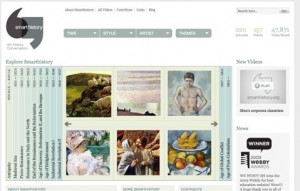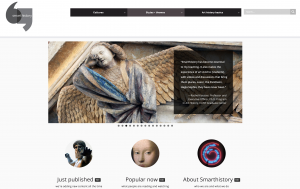Home » Search results for 'smarthistory'
Search Results for: smarthistory
The Technology of Smarthistory
(A long and technical post follows. If you don’t care to read it, if you’re of the TL;DR school, then go, right now, to Smarthistory.org and take a look at what kind of a beautiful OER can be made with WordPress.)
As anyone who knows me knows, I’m a big supporter (and helper, I guess) of Smarthistory (one of the most important Open Educational Resources on the web). I’ve been involved since the beginning. I’ve posted about it before, more than once. But Smarthistory has just reached another important milestone. For years it was an independent stand-alone website, with several different designs. The original iteration was in WordPress. I built that one, and it looked…well, see for yourself.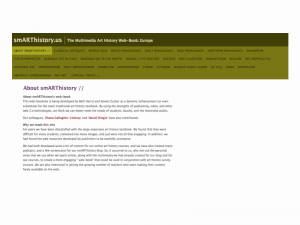
That site was the beginning of Smarthistory and it did a lot of the good things that Smarthistory still does. And I was proud to have built it with open source tools and for free. It even won an award, because it did work.
Then there was a small grant and a new design and new site in another open source CMS, ModX. I didn’t build that one, and the design was much better as was the functionality.
That one actually won another award, a Webby, and got a lot more attention. It was a great and beautiful site. Then Smarthistory became part of Khan Academy, and eventually keeping up the separate website wasn’t viable anymore. So the Smarthistory site went to the Internet Wayback machine.
Well, now, once again, Smarthistory is an independent site! Beth and Steven have a blog post announcing and explaining the new setup. And what their goals were.
The new site is even more gorgeous than before–I think–and even more functional. Some of the goals (as Beth and Steven explain) were to make the art the beautiful center, and to use the menus as teaching tools. That point–that information architecture can be a kind of pedagogy, is one that I hope to take up at some length in a later piece. Here I just want to detail, for those who might be interested, just how I made the site happen with WordPress and gave it the kind of elegance and functionality it needed to have.
So let’s dig into some of the technical details.
Smarthistory is running on WordPress, hosted by the wonderful folks at Reclaim Hosting.
Smarthistory is using a child theme based on the Customizr theme. This is a very bare-bones theme, and very clean (letting the images take the stage). It is also somewhat difficult to work with, since it doesn’t use exactly the standard WordPress setup of template files, and all the functions are controlled by hooks…which are sometimes not so well documented.
That child theme uses quite a bit of custom css (and, unfortunately, a lot of the !important declaration. I know that’s not usually best practice, but in this case it was often necessary). In some cases I had to use CSS to duplicate what customizr does for some of its non-template templates. One example of that is the Popular Now page, which, like the Browse by Image pages, came out particularly nicely.
There’s also a rather extensive custom functions.php file. (I’m happy to share both of those, in detail or in full, if anyone wants).
And then there are the plugins…we’re using a lot of standard ones (akismet, for example), but there are some really special ones we discovered and used. Here are the most important–all highly recommended for anyone working on any kind of similar project. Most are free.
Ajax Search Lite provides the really powerful and image-friendly (with thumbnails!) search bar.
Co-Authors Plus allows us to have authors listed for articles (and even more than one author, hence “co-authors”) who do not have to have an account on our WordPress system. Even better, it gives us (with some special help from the great Daniel Bachhuber, formerly of CUNY, who originally wrote the plugin) a very beautiful and functional alphabetical list of all the site’s contributors. And each of them has a particularly nice author page.
Maps Marker Pro let us make custom maps which are so important to telling historical stories.
NextEnd Accordion menu let us have very specific and contextual left-side nav menus, different on different pages (the top-nav is a different plugin–see below).
Ubermenu gave us that top nav. This is an absolutely amazing responsive menu, and when a site has such a large and complicated structure, this is critical.
Of course the site is Creative Commons licensed…and I consider that goes for the technical details, too. So anyone who has questions about how we made things or made them work…I will always share and answer!
To make a site with (literally) hundreds of pages and (literally) hundreds of different menu items, and to make that into a resource that teachers and learners anywhere can use anytime for free…I am so happy and proud to have been involved with that! And I should also mention the great assistance of Gwen Shaw and Nara Hohensee, both CUNY colleagues, who put in long hours and excellent work in getting the site ready for launch.
Smarthistory and the Google Art Project
Big news today in the world of art–and the world of teaching and learning with and about art–and the world of “jailbreaking” the museum (or access to all kinds of cultural knowledge).
Actually it’s two items of big news.
The first is Google’s announcement of version 2 of their already tremendous Google Art Project. They’ve now got 151 museums, from 40 countries (up from only 17 when they first launched). That’s 32,000 works of art. But these are not just little clipart low-quality watermarked jpgs. They’re gorgeous, high-resolution, full color, zoomable, suitable-for-study images. For some of them there is even “museum view” which lets you simulate walking around the museum and seeing the art in the context where it currently sits.
And then there’s the other fact, which of course has a strong personal resonance for me (on many levels!). For quite a few of these works of art (over 100), there are videos made by the wonderful folks at Smarthistory. Of course these add to the enjoyment, the understanding, the learning, the questioning of the art. A great example, a favorite of mine, is Pieter Brueghel the Elder’s Tower of Babel. It’s fantastic, with so much to see, but it’s in the Kunsthistorisches Museum in Vienna. Except now, it’s not only there, it’s also got a version on the Google Art Project. Take a look. Zoom in. Pan around. Really see what’s happening there. And then click on the “Details” link at the top of the screen, and you won’t only see the “normal” kind of details you might expect (description, map, style, material), but you’ll also see a video.
And that video, like over 100 others on the new Google Art Project, comes from the one and only Smarthistory team. Conversational, informal, engaging, informative and provocative…just what we want and expect and need!
As the Smarthistory team says in their announcement:
We jumped at this opportunity because the Art Project has such enormous educational potential. It is critical to gather works of art from different institutions to tell the nuanced stories of art history. The Art Project brings together works of art from 151 museums in 40 countries within a cohesive visual environment. The high resolution images, powerful zoom function, “Museum View” (an interior version of “Street View”) and the ability to collect and annotate images, are all features that are ideal for teaching and learning.
Viva the Museum without Walls!
Smarthistory joins Khan Academy
Big news today in the field of Open Educational Resources!
I’ve posted before about my admiration for smarthistory.org (and I do have a personal connection!). Today the news is out that they have joined forces with the Khan Academy. Two fantastic OERs are now working together, and the world of open learning, available to all, is wider than before. This means great things for smarthistory, great things for Khan Academy, and great things for learners everywhere.
Here’s the announcement direct from Smarthistory:
Dear Smarthistory Contributor/Supporter,
We have some terrific news! As you know, Smarthistory has been growing fast. Our content and usage numbers are way up (visits are now over 150,000 per month) and we have been working hard to make the site an indispensable resource for students and informal learners. At the same time, we have been actively looking for similar initiatives. For the past year, the one that we were most excited about was the Khan Academy (www.khanacademy.org). So you can imagine our excitement when Sal Khan contacted us. To make a long story short, we’ve joined forces.
Rest assured, Sal and the rest of his amazing team are committed to the same principles as Smarthistory. Their content is entirely free, uses the same creative commons license that we do, and they accept no advertising. Like Smarthistory, Khan Academy is fully committed to open education, and they are also a not-for-profit. And Smarthistory isn’t going away, it will retain its own identity, but within the Khan Academy umbrella. As of today, Smarthistory.org simply redirects to Smarthistory.khanacademy.org (they have MUCH better servers!) (EDIT–Not anymore!)
If you’re not familiar with the Khan Academy, here’s some info from their site:
Khan Academy is a not-for-profit with the goal of changing education for the better by providing a free world-class education to anyone anywhere.
All of the site’s resources are available to anyone. It doesn’t matter if you are a student, teacher, home-schooler, principal, adult returning to the classroom after 20 years, or a friendly alien just trying to get a leg up in earthly biology. The Khan Academy’s materials and resources are available to you completely free of charge.
And if you haven’t seen it, watch Sal’s TED Talk to get a better idea of their history and goals and how they’re using learning analytics to “flip” the classroom:http://www.ted.com/talks/salman_khan_let_s_use_video_to_reinvent_education.html
or read this recent article in the Economist: http://www.economist.com/node/21529062.
We look forward to continuing to work together to create open resources for art history education.
Best,
Beth & Steven
Khan Academy’s blog post about the news is here.
Why videos?
In the Cathy Davidson “History and Future of (Mostly) Higher Education” MOOC, I’m really intrigued by her decision (or maybe Coursera’s decision?) to have so much of the content delivered by means of video. Particularly I’m intrigued (or even concerned) by the use of video that takes so little advantage of the affordances of the video medium.
In every one of the videos (all of which are much longer than I would recommend for any online video) I’ve found myself wondering “why does this need to be a video? Why not just text?”
There are so many great examples of educational video which uses what video can do. From the RSA Animate work, to the California Academy of Sciences series on biodiversity (for example). Or of course Khan Academy in general and Smarthistory in particular.
We know so many great ways to make educational video, and we already have text (even with illustrations). Why make videos that just translate text (or even lectures) into video?
I’ve written about this before. And I’m far from the only one. So I’m wondering what was the thinking behind doing things in the Coursera course the way that (at least so far) they’re being done.
In my own course (see particularly the mini-lectures)–not a MOOC, since it was far from massive, but generally open and certainly online, that I taught twice, 3 and 4 years ago, I thought about this a lot and chose to have text with hyperlinks and illustration (and broken down into much smaller pieces, and more readable), rather than me talking to the camera. And we (as a class) discussed that choice and discussed what video can and can’t do (as well as voicethread, discussion forums, audiobooks, traditional textbooks, etc). (And of course, the class used plenty of video, when that was appropriate. Just not video of me talking to the camera).
I really wonder what are the advantages (or at least differences) in having mini-lectures that are like mine (in the “Introductions and Foundations” section or “What is Learning and What is Literature” or any of the others), vs. having me say that same information (maybe with pictures on the side or subtitles) to the camera from a couch with a cup of coffee in my hand.
The Emerging Doitocracy
A meritocracy is not enough, when it requires someone, somewhere, to recognize that merit as an abstract concept. We live in a world where, increasingly, the reliability of credentialing is suspect. Where the proof of merit is not a degree or a position or a title. In that situation, when it’s tough to trust a credential as being proof of anything other than the fact of the credential, then it makes sense that recognition, authority, prestige, rewards…all come to the people who are actually creating, not waiting.
This is what I think of as the doitocracy (do-it-ocracy). It’s not a phrase I coined originally (although I don’t remember where I heard it), but it’s a concept I’ve been thinking and writing about in various ways for some time. I think the doitocracy probably starts in the Open Source Software movement, where if you want something new, you go right ahead and fork, and we can trace it through wikipedia, where if something is wrong, you go ahead and edit, or if there’s no entry, you go ahead and write one. And of course it’s a concept that has to have much older roots, too.
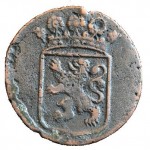
In a doitocracy, whoever does the most, gets the most credit, and the doing comes before the credit. In teaching and learning I see this everywhere these days. I see the most effective teaching and learning of physics and engineering (optics, electronics, electromagnetic theory) going on in places like CandlePowerForums. Biology, chemistry and genetics
are being studied at length, in international communities, at Cichlid-forum. For philosophy, literary criticism and performance studies one could begin at TV Club. And I haven’t even begun to touch political science, history, gender studies, and on and on. People want to learn, they want to think, they want to critique, and the best instances of where that is happening is where people (enabled by digital tools) are just coming together to do it. They’re not enrolling in classes or programs of study (or even MOOCs). The best learning examples are these self-built learning spaces (my colleague Patrick Masson said this beautifully early on in the current MOOC-mania: “I’ve been in this really good MOOC for the past 20 years. It’s called ‘The Internet'”).
And it’s more than ideas. People are making things, creating practical, beautiful, complicated and enriching…and new things. And they’re explaining how they did it and letting others improve on their designs, and yes, selling their things, too. At instructables and at Maker Faires and for sale on etsy. Of course some of the things are virtual, digital things–video and reporting and photography and animated gifs and stories and guidebooks and more.
And then there are places where both of these moves are happening together–where people want to teach something, so they make a virtual digital thing that teaches it. The example of this most famililar to me, of course, is smarthistory.org, where a couple of teachers wanted to do a better job of teaching their own students. So they sat down with $5/month shared hosting, $200 or so worth of hardware and software, and they built a learning space which today reaches three quarters of a million learners every semester, rather than a hundred or so. (And is now part of the Khan Academy, which of course is also an exemplary participant in the doitocracy. Sal Khan didn’t wait for a credential or permission–he just started making videos, posting and sharing them). Or there’s our own CUNY Academic Commons, right here where Prestidigitation lives. Instead of asking for CUNY community, or waiting for someone to package it for us or build it for us (or sell it to us!) we just built it. (“If you build it, they will fund,” my colleague George Otte has often said of this).
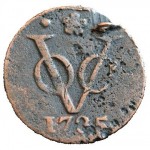 Where this becomes a doitocracy, rather than just doing it, where the -ocracy comes in, is in that “they will fund” part of the equation. Like Corey Doctorow’s concept of “whuffie,” the currency of prestige in the doitocracy, the recipe for recognition, is from the quality of the work itself. The doitocracy is more than a meritocracy, but it’s a meritocracy, too, because when you do it, and do it well, that’s when people recognize you as the expert, that’s when they give you attention and links and retweets and yes, real currency, funding, too. Sometimes this reputation is actually codified in thumbs-ups or likes or karma points, other times it’s just having your name ring out (or your username and avatar. Real names not required). When Fogelhund talks about spawning Tanganyikan cichlids, I listen, because from the posts he’s shared I know what he’s tried, when he’s succeeded and why he’s failed. When Jamie describes a new technique for anodizing titanium, I know from the quality of what he makes and sells that it’s a technique worth trying (assuming I ever want to anodize my own titanium!)
Where this becomes a doitocracy, rather than just doing it, where the -ocracy comes in, is in that “they will fund” part of the equation. Like Corey Doctorow’s concept of “whuffie,” the currency of prestige in the doitocracy, the recipe for recognition, is from the quality of the work itself. The doitocracy is more than a meritocracy, but it’s a meritocracy, too, because when you do it, and do it well, that’s when people recognize you as the expert, that’s when they give you attention and links and retweets and yes, real currency, funding, too. Sometimes this reputation is actually codified in thumbs-ups or likes or karma points, other times it’s just having your name ring out (or your username and avatar. Real names not required). When Fogelhund talks about spawning Tanganyikan cichlids, I listen, because from the posts he’s shared I know what he’s tried, when he’s succeeded and why he’s failed. When Jamie describes a new technique for anodizing titanium, I know from the quality of what he makes and sells that it’s a technique worth trying (assuming I ever want to anodize my own titanium!)
It would be a mistake not to mention that there is plenty of hard work involved in getting ahead in the doitocracy. It’s not just by magic or wishing that something great gets built (remember what makes a wizard!). Lots of people, lots of time, lots of energy, and heart and soul and spirit are behind that attitude of just doing it or just making it or just learning it. But it’s that old “where love and need are one, and the work is play for mortal stakes” idea. It’s the kind of work that is real work, and the fact that it is hard is just part of what makes it real.
It’s the new tools for communicating, creating, connecting that make the doitocracy work. And I think the challenge, especially in a school system that has relied too long on the “because I said so” model of motivation, is to give students the access to those tools in ways that will push them to the pleasure and the dedication, the engagement and the effort, that the doitocracy rewards and requires. We need students who will and can learn independently, finding and doing and making and sharing. Because those are the leaders in the doitocracy.
(one last note of thanks–my early thinking on this subject was confirmed and influenced by Alan Levine’s post “Your Work Speaks for Itself.” In the doitocracy, your work is your badge.)
Support an Open Educational Resource
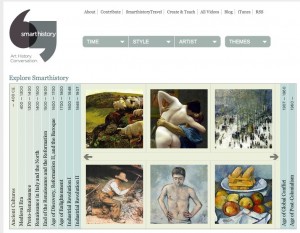
My own favorite Open Educational Resource is the webby- award- winning smarthistory.org (full disclosure– I do have a personal connection to the site and one of the founders!).
It’s a perfect example of what the future of the textbook can look like–embodying conversation, multiple media, a student-centered approach to learning, contextualized knowledge, active engagement, interdisciplinary learning, everything that the web can do that traditional textbooks can’t. And it’s completely free to students and faculty. And completely free in an arena (art history textbooks) where students usually have to spend large amounts of money for resources which aren’t nearly as useful for their learning.
But “free” usually means that somewhere, someone, is paying (TANSTAAFL). In this case, smarthistory has been funded by a combination of some generous grants, and a whole lot of volunteer time and attention and work from people who really care about it. That’s taken it a long way, and it’s very close to where it needs to be to become a true “textbook-killer.” After lots of research with college faculty and students, and high school teachers and students, and independent learners, all of whom are already using the site extensively, the smarthistorians have identified what it will take to make the site a comprehensive replacement for an art history survey textbook. They’re so close! To get over that final step, they’ve started a kickstarter campaign, to try to “crowd-source” the support they need. It’s an ambitious effort, and a real experiment to see if the community of users can, together, provide not just the intellectual and interactive support they’ve already been giving, but also a financial boost.
Smarthistory will always remain free and open to its users. That’s a commitment the team has made; it’s in the DNA of the project. With the help of the community, that can always be the case–for learners everywhere.
Visit the kickstarter page to watch a video intro and find out more.
Early iPad thoughts
So I’m writing this on Thursday, after receiving my iPad (no, I didn’t stand on line, I had it delivered!) on Saturday. That’s only about five days of use so far–but I do have some early indicators and ideas and reactions, and I thought I’d share them–especially because I just returned from a three-day trip to California (to Google–about which more in a later post), and I brought the iPad on the trip as my only computer. I left the laptop at home.
First–the simple bottom line. It’s a great device. It was just fine as my only device on the trip, and while I wouldn’t want it to be (nor is it meant to be) my only computer at all, it’s good for even an extended time away from home. So if you want only to know a simple thumbs up or down, read no further. Thumbs up all the way.
But the longer response is that there are several ways in which the device is great, and those are worth exploring. And of course there are ways in which it is not so great. I’ll get to those, too. So read on.
Why?
A student in my Alternate Worlds class asked “Professor Ugoretz, I was just wondering what inclined you to buy an IPad. I find the IPad to be another fad that symbolizes that one is keeping up in style.” I think that was a good question–and for me there are answers on several levels.
First, personally, I like new gadgets, I like to try them out and test them and see what they can do. I like to push them to their limits and beyond (I’m sure an iPad jailbreak will be available soon, and I’ll probably try that as I did with the iPhone). So maybe that is the “fad” aspect that my student was asking about. (But I certainly don’t much care what other people think of me having it, and I’m certainly not stylish in other ways.)
But it goes beyond the personal. Professionally, it’s part of my job to think about how new technologies can be or will be used in educational settings, and to take the opportunity to test that.
So there was never really any doubt in my mind that I would be trying the iPad right from the first.
What I love
The list is actually pretty long, but it all fits together under the category of the interface. I’ve seen lots of criticisms of the iPad saying that “it’s just a big iPod Touch” or “it’s just an underpowered tablet.” I think both of those miss a critical element of what this device is. It’s all about the interface. The iPad is designed around this fact, and that makes all the difference. Interacting with content without a mouse, with a direct touch of your own finger, makes everything more immediate and intimate. When you add the mobility of the iPhone, but with a truly usable screen-size and resolution, it’s a major advantage. I have had trouble letting go of the thing since I got it. You always want it in your hand.
It’s true that it’s a device more for consumption than for creation, which was a criticism I heard and shared before I held it, but it’s also true that consuming media through this interface is a radically different kind of consumption, closer to creation. More about that in the context of ebooks in a minute.
But it’s not just about consumption. It’s only been five days, and already (from the start, in fact) we have the iWork suite which really is all about creation. I’m not too experienced with and haven’t thought much about Numbers yet. But Keynote and Pages on the iPad are completely different experiences than they were on a computer. Keynote was always already far superior to MS PowerPoint, and on the iPad it becomes a whole new thing entirely. Moving images on a slide with your finger, twisting and rotating them with two fingers, aligning them and rearranging them and having text flow around them automatically all with your own body as the only real tool you notice–that makes the process of creating a slideshow presentation into something like building or sculpting. And a “word processing” “document” that can so easily include images which are really integrated with the words permits the easy (for everyone, not just the adept) creation of documents that do things that paper-based (“dead-tree”? “old-fashioned”?) documents can’t. Creating documents (and of course presentations) can be more than just text–with ease and elegance in the process, too.
When you remove obstacles like a mouse (even if it didn’t seem like such a big obstacle before) from the process of making, building, presentations or documents, those presentations or documents can be a more direct and more informal and more frequently created and creative experience. I see that as an unqualified good.
Back to consumption–something similar happens there. I’ve been reading ebooks on the small screen (beginning with a Palm V, then a Treo, then an iPhone) for a long time. I have never really minded the small screen, and I have always very much liked, loved, the backlight (I am a person who absolutely can not sleep without reading first, and the ebook with backlit screen is the perfect reading-in-bed solution). But the iPad takes this to another level. The big bright screen (and never let anyone tell you that color isn’t important) is great. The page-turn interface is good (although not terribly important to me). But making the text searchable (Ann Kirschner, my colleague at Macaulay, calls this an “instant concordance” and that’s a perfect term) and linkable to the web or wikipedia and integrated with a dictionary, at the touch of a finger, really takes advantage of what electronic books can do that paper books can not. I don’t think ebooks should replace paper books. I don’t think they ever will. Paper books can do things that ebooks can not. But the opposite is also true. The iPad is the first device I’ve seen that really elegantly and completely lets ebooks be what they can be at best, instead of just seeing them as some kind of partly adequate substitute for a paper book.
Where this fits in
Let me take that ebook theme a little farther–specifically in terms of what this could mean for education. There has been a lot of attention to Theodore Gray’s simply amazing “The Elements” iPad app. This is where I think ebook initiatives for higher education should be going. Not to simply re-create paper textbooks, but to do things that an ebook can do that paper can not. The use of multimedia, the hyperlinks, the brilliant color and sound and factual information. This is a learning tool. A book is, too, but this is a radically different kind of learning tool. It’s not really fair to call it a textbook.
More than just the multimedia and flashy (which are not trivial) effects, the tone of the factual information is critically important. I think that web-based (or iPad-based) educational resources have the opportunity–the obligation–to explore different tones that more closely fit their media. This is one of the huge strengths of the best (in my humble, biased, opinion) open educational resource right now, Smarthistory (for which I eagerly await the iPad app!)
Where the iPad can fit in higher education is in two connected areas– first, in helping to make possible these new ways of consuming content–these kinds of educational resources, learning tools, which are designed for the new medium and its own advantages, rather than trying to replicate the previous medium. So that “consuming” really isn’t the right word–there’s a kind of direct interaction with the content–almost a type of creation itself. And second, in helping to make possible these new ways of creating content–again taking advantage of exactly what the medium can do–using the tools (fingers) and the ideas directly, to create what you see and think and mean. I really want to see where students will go with this–what kinds of presentations and effects and documents they will create and what kinds of responses and interactions they will have. And third, that ease and intimacy of creating content and interacting with already-created content is really going to encourage and multiply that more informal, conversational, dialogic, provisional, digressive, tone. And all of that is what will be coming soon.
What is to come
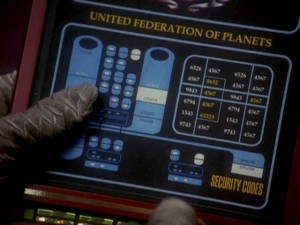
What will be coming soon? That’s the real beauty here. The apps that are there now are only hints of what I’m sure will be coming. Video editing? No real reason it won’t be possible. Social annotation of images or texts? Absolutely needs an app and I’m sure we’ll see one. There’s room for brilliant developers here. And rewards. Sure, Apple controls the app store. I don’t see that as being such a huge problem as some of my colleagues do.
We just don’t really know how the apps are going to come, when and what they’ll be, and that is really what is going to make this device shine. For the iPhone, the apps have always been the main advantage–and for the iPad that’s going to be even more the case.
And hardware improvements, too–like a camera for videoconferencing, I guess–are certainly coming down the road. This is the very first device of its type (no previous tablet has been in this genre. It’s not the same kind of thing). So there are naturally going to be competitors and improvements and new versions. But long before any of that, we’re going to see more and more and better and better new apps. I’m hoping some of our students will be building them!
What is not so great
No review would be complete without a few complaints! No device is perfect. The keyboard is going to take some getting used to. I think for extended writing, I’m going to want to use an external keyboard. I can’t really touchtype very well on the iPad keyboard using all my fingers–even in landscape mode.
The rich text editor in WordPress is not compatible with the iPad browser in some way. You can use the html edit window, but can’t type or edit at all in the rich text. I’m sure there’s going to be a quick and easy solution for that soon (and the iPad WordPress app is OK–but not great for a WPMU install. All of this may be moot with WordPress 3.0).
And this is not an iPad issue, but a Google Docs issue. You can view, but you can not edit, Google Docs (except spreadsheets) in the iPad browser (same is true for every mobile browser–including the iPhone). I’ve been told that Google, as well as QuickOffice and other third parties, are working on fixes for this very soon. Similarly, I’d like to see some close integration (opening, saving, editing) with Dropbox. That could really make the whole cloud thing work with the iPad in great ways.
There are also some typical 1.0 type glitches. Some websites don’t load or crash safari. Some apps aren’t quite stable yet. But those are really minor, infrequent, and to be expected. This is a 1.0 version, after all! I have not experienced the wifi issues that some users have reported. Wifi has been strong and reliable for me so far.
So that’s where things stand right now! I’m not the only iPad reviewer on the web by any means–but that’s how it looks from my own perspective.
A Webby Award for Open Education
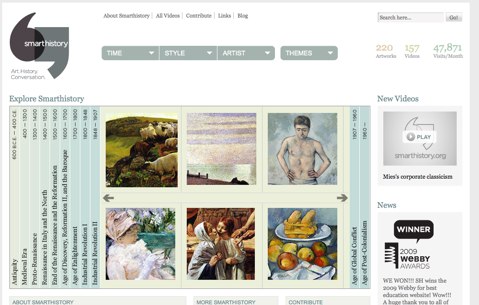 The annual Webby Awards (what the NY Times calls “the internet’s highest honor”) were announced today, and in the education category, the very-deserving winner was the excellent Smarthistory.org site (full disclosure–the site is the work of my wife and her colleague, and I’ve had some marginal technical involvement in it myself from the beginning). Smarthistory is an educational site actually designed and built by educators–two art historians who wanted alternatives for teaching and learning. Dissatisfied with what textbooks, or even ArtStor, could offer, and not interested in closed models or walled gardens, they started from scratch with open source tools (beginning with WordPress, and now using ModX). The site is dedicated to open sharing of educational resources, and makes full use of the tools and abilities of Web 2.0. It’s about art and history…and even more about conversation and interaction around those. But it’s hard to describe–better just to experience it. To see a site like this win this prestigious and competitive award, beating established museums and huge well-funded foundations, is more evidence of how when things get done right, they work!
The annual Webby Awards (what the NY Times calls “the internet’s highest honor”) were announced today, and in the education category, the very-deserving winner was the excellent Smarthistory.org site (full disclosure–the site is the work of my wife and her colleague, and I’ve had some marginal technical involvement in it myself from the beginning). Smarthistory is an educational site actually designed and built by educators–two art historians who wanted alternatives for teaching and learning. Dissatisfied with what textbooks, or even ArtStor, could offer, and not interested in closed models or walled gardens, they started from scratch with open source tools (beginning with WordPress, and now using ModX). The site is dedicated to open sharing of educational resources, and makes full use of the tools and abilities of Web 2.0. It’s about art and history…and even more about conversation and interaction around those. But it’s hard to describe–better just to experience it. To see a site like this win this prestigious and competitive award, beating established museums and huge well-funded foundations, is more evidence of how when things get done right, they work!

